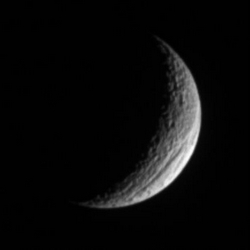
Tethys shows off its great scar. Image credit: NASA/JPL/SSI Click to enlarge
A crescent Tethys shows off its great scar, Ithaca Chasma, for which the moon is renowned. The chasm is 100 kilometers (60 miles) across on average, and is 4 kilometers (2 miles) deep in places.
See Steep Scarps for a much closer view of the chasm taken during a Cassini flyby.
Ithaca Chasma is the most prominent sign of ancient geologic activity on Tethys (1,071 kilometers, or 665 miles across), whose surface is characterized principally by heavy cratering.
The lit surface visible here is on the moon’s Saturn-facing hemisphere. North on Tethys is straight up.
The image was taken with the Cassini spacecraft narrow-angle camera on Nov. 28, 2005 using a filter sensitive to wavelengths of infrared light centered at 930 nanometers. The view was acquired at a distance of approximately 1.1 million kilometers (700,000 miles) from Tethys and at a Sun-Tethys-spacecraft, or phase, angle of 123 degrees. Resolution in the original image was 6 kilometers (4 miles) per pixel. The image has been magnified by a factor of two and contrast-enhanced to aid visibility.
The Cassini-Huygens mission is a cooperative project of NASA, the European Space Agency and the Italian Space Agency. The Jet Propulsion Laboratory, a division of the California Institute of Technology in Pasadena, manages the mission for NASA’s Science Mission Directorate, Washington, D.C. The Cassini orbiter and its two onboard cameras were designed, developed and assembled at JPL. The imaging operations center is based at the Space Science Institute in Boulder, Colo.
For more information about the Cassini-Huygens mission visit http://saturn.jpl.nasa.gov . The Cassini imaging team homepage is at http://ciclops.org .
Original Source: NASA/JPL/SSI News Release
